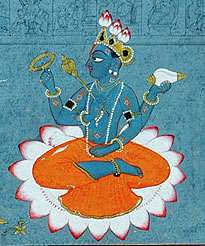Venkateswara
Lord Venkateswara (Sanskrit: वेङ्कटेश्वर, IAST: Vēṅkaṭēśvara), also known as Śrīnivāsa, Bālājī, Vēṅkaṭa, Venkata Ramana, Vēṅkaṭāchalapati, Tirupati Timmappa, Ezhumalaiyaan,Edukondalavaadu, Aapadamokkulavadu and Govindha,[1] is a form of the Hindu god Maha Vishnu. Lord Venkateswara is the presiding deity of Tirumala Venkateswara Temple located in Tirupati, Andhra Pradesh, India.
| Lord Venkateswara | |
|---|---|
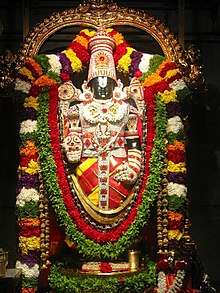 | |
| Devanagari | वेङ्कटेश्वर |
| Sanskrit transliteration | Vēṅkaṭēśvara |
| Telugu | వేంకటేశ్వర |
| Affiliation | Maha Vishnu |
| Abode | Vaikuntam, Tirumala |
| Mantra | Om Namo Venkatesaya, Om Namo Narayana |
| Weapon | Shankha, Chakra |
| Symbols | Namam |
| Mount | Garuda |
| Region | Andhra Pradesh, India |
| Consorts | Lakshmi, Padmavathi,Bhumidevi |
| Part of a series on |
| Vaishnavism |
|---|
 |
|
Holy scriptures
|
|
Sampradayas
|
|
Related traditions |
|
|
Etymology
Venkateswara literally means "Lord of Venkata".[2][3] The word is a combination of the words Venkata (the name of a hill in Andhra Pradesh) and isvara ("Lord").[4] According to the Brahmanda and Bhavishyottara Puranas, the word "Venkata" means "destroyer of sins", deriving from the Sanskrit words vem (sins) and kata (power of immunity).[5]
It is also being said Venkata is combination of two words 'ven' (keeps away) and 'kata' (troubles). Being that said Venkata means 'who keeps away troubles' or 'who takes away problems' or any other sentence in similar context.
Legend
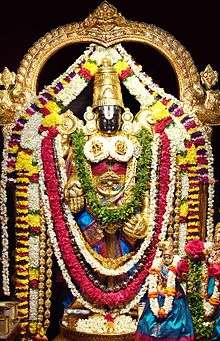
Every year, lakhs of devotees donate a large amount of wealth at the Tirumala Venkateswara Temple at Tirupati, Andhra Pradesh. [6] There is a great legend behind this incarnation of Lord Vishnu. Once, there was a ritual to be conducted. The sages and pontiffs for the Yagya were in a dilemma that for which God is the ritual to be done. The sages called for Sage Bhrigu, one of the Saptarishis to ask for which God should the ritual be done. To test the ideal God, Bhrigu did a test. He first went to King of Gods, Indra. Indra did not at all recognize Bhrigu's presence and was busy in mesmerising the dance of devadasis in the heaven. Bhrigu cursed Indra that he would only be referred as an egoistic soul all over the universe. He next visited Brahma. Brahma was busy with his four heads in chanting the Vedas, doing meditation, creating the world and spending his time with his consort, Saraswati. Bhrigu cursed Brahma that he would be not worshipped by the creatures on earth anymore for not obeying him. Next he visited Lord Shiva. Shiva was busy in his Rudradhyanam and his consort, Mother Parvati was worshipping Shiva's feet. Bhrigu cursed Shiva that he would be worshipped only as a stone called Lingam. At last, Bhrigu went to Lord Vishnu. Vishnu was sleeping on the bed of serpents and Lakshmi was at his feet. When Bhrigu arrived, he first saw Vishnu's feet and felt too humiliated. He thus kicked Vishnu on his chest and awakened Vishnu started massaging Bhrigu's feet and served him great hospitality. Bhrigu was pleased and ordered the sages to perform the rites for Vishnu. Goddess Lakshmi, also referred as Sri, had a fight with Lord Vishnu as she felt that Bhrigu insulted her indirectly by hitting Vishnu on his chest where Sri lived and thus left Vaikuntha. She came and settled on earth in disguise in the ancient city of Karvir(Kolhapur) and meditated for Vishnu where today the Mahalaxmi temple is situated. Lord Vishnu soon arrived on earth searching for Goddess Lakshmi. But He failed to find her and instead settled on Seshachalam hills inside an anthill. Like this, Lord Vishnu reached the place of piligrimage of Lord Varaaha Swamy in Tirupati Tirumala. Lord Vishnu sat inside an anthill which was situated under a tamarind tree and started chanting the name of Goddess mahalaksmi. [7]
The whole earth became gloomy. On the request of Parvati and Saraswati, Lord Shiva and Lord Brahma incarnated as a cow and a calf respectively in the Chola kingdom.This cow and calf were being grazed daily by a shepherd of Chola kingdom in the Seshachalam hills. The cow and calf, everyday used to deposit their milk in the anthill to lessen the thirst of Vishnu. Due to daily program, the cow and calf became pale and unhealthy. The Chola king and shepherd noticed this and felt something suspicious. The next day the shepherd took the animals for grazing and like everyday, the cow and calf deposited their milk in the anthill. The Chola king saw this act and launched his arrow towards the cow and calf. But in order to protect them, Vishnu arose from the anthill and the arrow hit Vishnu's leg. The Chola king was sorry for his mistake and surrendered at the Lord's feet. Lord presented him a boon that he would marry his daughter in his next birth. In his next birth, Vishnu incarnated as Srinivasa to a woman named Vakula Devi. It is said that in Dwapara Yuga, Krishna presented Yashoda a boon that Krishna will be again born to Yashoda in Kali Yuga. Vakula Devi was reincarnation of Yashoda. Meanwhile, Goddess Lakshmi of Karvir took birth at the palace of Aakasha Raja, the next birth of The previous Chola king. Srinivasa was a forest dweller. During the search, Lord Srinivasa met the beautiful girl named Padmavati. They both fell in love and decided to get married as per the boon of Vishnu to Chola king in previous birth.
The father of Padmavati asked for a huge bridal price and to pay the money Lord Vishnu took a large loan from Kubera, the Hindu god who is the treasurer of wealth. Kubera gave the loan on the condition that Vishnu cannot return to Vaikunta (heavenly abode) without paying off the debt.
Lord Vishnu resides at Tirumala,that is the Seshachalam hills as Tirupati Venkateswara without returning to Vaikunta until the payment is made. To help him repay his debt, devotees offer him everything, including hair and wealth and in return Lord Vishnu fulfills their prayers.
In 2018, an RTI petition was filed by Narasimha Murti,[8] an RTI activist[8] belonging to Bangalore, seeking to know "how much Lord Venkateswara had received from Lord Kubera and how many more years it would take for the devotees to clear this debt".[8]
Deity
Venkateswara, an avatar of Vishnu is the presiding deity of the Tirupati temple. It is believed that the Moolavirat is Swayambhu (self manifested).
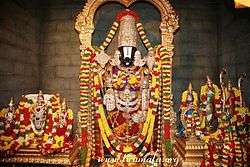
Pancha berams
As per Vaikanasa agamas, Venkateswara is represented by five deities(berams) including the Moolavirat which are together referred to as Pancha beramulu(Pancha means five;Beram means Deity).[9] The five deities are Dhruva Beram(Moolavar), Kautuka Beram, Snapana Beram, Utsava Beram, Bali Beram. All the pancha berams are placed in the Garbha griha under Ananda Nilayam Vimanam.[9]
- Moolavirat or Dhruva Beram- In the centre of Garbha griha, under the Ananda Nilayam Vimana, the Moolavirat of Venkateswara is seen in standing posture on lotus base, with four arms, two holding Shanka and Chakra and one in Varada posture and other in Kati posture. This deity is considered the main source of energy for the temple and adorns with Namam and jewels including vajra kiritam(diamond crown), Makarakundalams, Nagabharanam, Makara Kanti, Saligrama haram, Lakshmi haram.[9] Venkateswara's consort, Lakshmi will be staying on the chest of the Moolavirat as Vyuha Lakshmi.
- Bhoga Srinivasa or Kautuka Beram -- This is a small one-foot (0.3 m) silver deity which was given to the temple in 614 AD by Pallava Queen Samavai for conducting festivals. Bhoga Srinivasa is always placed near the left foot of Moolavirat and is always connected to the main deity by a holy Sambandha Kroocha.This deity will receive many daily sevas(pleasures) on behalf of Moolavar and hence known as Bhoga Srinivasa(In Telugu: Bhoga means Pleasure). This deity receives Ekanthaseva daily[10] and SahasraKalasabhisheka on Wednesdays.
- Ugra Srinivasa or Snapana Beram - This deity represents the fearsome(Telugu: Ugra means angry) aspect of Lord Venkateswara.[11][12] This deity is the main processional deity until 1330 CE when it was replaced by Malayappa swami deity.[9] Ugra Srinivasa remains inside the sanctum sanctorum and comes out on a procession only one day in a year: on Kaishika Dwadasi, before the sunrise.[12][11] This deity receives daily abhishekam on behalf of Moolavirat, giving the name Snapana Beram(Sanskrit: Snapana means cleansing)
- Malayappa swami or Utsava Beram - Malayappa is the processional deity(Utsava beram) of the Temple and is always flanked by the deities of his consorts Sridevi and Bhudevi. This deity receives all festivals like Brahmotsavams, Kalyanotsavam, Dolotsavam, Vasanthotsavam, Sahasra deepalankarana seva, Padmavati parinyotsavams, pushpapallaki, Anivara asthanam, Ugadi asthanam etc.
- Koluvu Srinivasa or Bali Beram- Koluvu Srinivasa represents Bali Beram. Koluvu Srinivasa is regarded as the guardian deity of the temple that presides over its financial and economic affairs. Daily Koluvu seva(Telugu: Koluvu means engaged in) will be held in the morning, during which, the previous day's offerings, income, expenditures are notified to this deity, with a presentation of accounts. Panchanga sravanam also will be held at the same time during which that particular days Tithi, sunrise and sunset time, nakshatra are notified to the Venkateswara.
Songs and Hymns
Sri Venkateswara Suprabhatam is the first and pre-dawn seva performed to Lord Venkateswara at Sayana Mandapam inside sanctum sanctorum of Tirumala Temple. 'Suprabhatam' is a Sanskrit term which literally means ‘Good Morning’ and is meant to wake up the Lord from His celestial sleep.[13][14] Sri Venkateswara Suprabhatam hymns were composed by Prathivadhi Bhayankaram Annangaracharya during 13th century and consists of 70 slokas in four parts including Suprabhatam(29), Stotram(11), Prapatti(14) and Mangalasasanam(16).[14][13]
Tallapaka Annamacharya (Annamayya), the poet saint[15] of 14th century, one of the greatest Telugu poets and a great devotee of Lord Venkateswara, had sung 32000 songs in praise of Lord Venkateswara.[16][15] All his songs which are in Telugu and Sanskrit, are referred to as Sankirtanas and are classified as Sringara Sankirtanalu and Adhyatma Sankirtanalu.[15] One of his songs is as follows:
Telugu
అన్ని మంత్రములు ఇందె ఆవహించెను
వెన్నతో నాకు గలిగె వేంకటేశు మంత్రము
నారదుడు జపియించె నారాయణ మంత్రము
చేరె ప్రహ్లాదుడు నారసింహ మంత్రము
కోరి విభీషణుడు చేకొనె రామ మంత్రము
వేరెనాకు గలిగె వేంకటేశు మంత్రము
IAST
anni mantramulu nindē yāvahiñcenu |vennatō nāku galige vēṅkaṭēśu mantramu ||
nāraduḍu japiyiñce nārāyaṇa mantramu |
cēre prahlāduḍu nārasiṃha mantramu |
kōri vibhīṣaṇuḍu cēkone rāma mantramu |
vēre nāku galige vēṅkaṭēśu mantramu ||
All mantras originated here, I got venkaTESa mantram from infancy itself. Narada chanted nArAyaNa mantram, prahlAda got nArasimha mantram vibheeshaNa lovingly took up rAma mantram, I got venkaTESa mantram.
Other Venkateswara temples
- India
Paduthirupathi Venkataramana Temple, Karkala, Karnataka
Shri Lakshmi Venkatesh Devasthan
Chatribagh, Indore, Madhya Pradesh
Kodandarama Temple, Buchireddypalem,Nellore District , Andhra Pradesh
- Mauritius
- Sri Prasanna Venkateswara Swami Temple, La Laura-Malenga
- United States of America
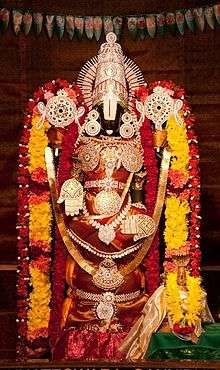
- Malibu Hindu Temple, California
- Venkateswara Temple, Minnesota
- Sri Venkateswara Temple, Pittsburgh
- Sri Venkateswara Temple of North Carolina
- Sri Balaji Temple, Bridgewater, NJ
- Sree Venkateswara temple, Richfeild Ohio(Cleveland area)
- Hindu Temple of Atlanta, Riverdale GA
- Sri Venkateswara Swami (Balaji) Temple, Aurora Illinois(Chicago Area)
- Sri Venkateswara Temple of Central Ohio, Columbus Ohio
- Australia
- Venkateswara Temple, Helensburgh
- England
Shri Venkateswara (Balaji) Temple, West Midlands, England
See also
| Wikimedia Commons has media related to Venkateshwara. |
References
- Tourist Guide to Andhra Pradesh. Sura Books. 1992. p. 21.
- Daniel C. Maguire; Harold Coward (2000). Visions of a New Earth. SUNY Press. p. 115.
- William Schweiker (2008). The Blackwell Companion to Religious Ethics. John Wiley & Sons. p. 474.
- John Stratton Hawley and Vasudha Narayanan (2006). The Life of Hinduism. University of California Press. p. 233.CS1 maint: uses authors parameter (link)
- Nanditha Krishna (2000). Balaji-Venkateshwara, Lord of Tirumala-Tirupati. Vakils, Feffer, and Simons. p. 49.
- "Why do we Hindus offer Gold and large amount of money at Tirupati Balaji Temple?". Hindu Blog. 31 October 2015. Retrieved 25 July 2016.
- HS, ANUSHA (2020). Stories on lord Venkateshwara series - 1: From various sources. Independently published (April 25,2020). pp. 1 page. ISBN 979-8640227642.
- Hemanth Kashyap (11 December 2014). "He Seeks Answers from the God of 'Big' Things". Bangalore Mirror. Retrieved 20 October 2016.
- Sri Venkateshwara. Shantha Nair.
- "Tiruppavai to replace Suprabhata Seva". times of india. 8 December 2016. Retrieved 27 July 2018.
- "Much awaited Kaisika Dwadasi falls on November 11". times of india. 6 November 2016. Retrieved 27 July 2018.
- "Fervour marks 'Kaisika Dwadasi' at Tirumala". The Hindu. 2 December 2016. Retrieved 27 July 2018.
- V.K., Subramanian. Sacred Songs of India, Volume 10. Abhinav publications. p. 59. ISBN 81-7017-444-9.
- "Tirumala Tirupati Devasthanams-Suprabhatam". Tirumala Tirupati Devasthanams. Retrieved 29 July 2015.
- Poet Saints of India. Sterling Publishers Pvt. Ltd. 1996.
- 101 Mystics of India. Abhinav Publications. 2006.
